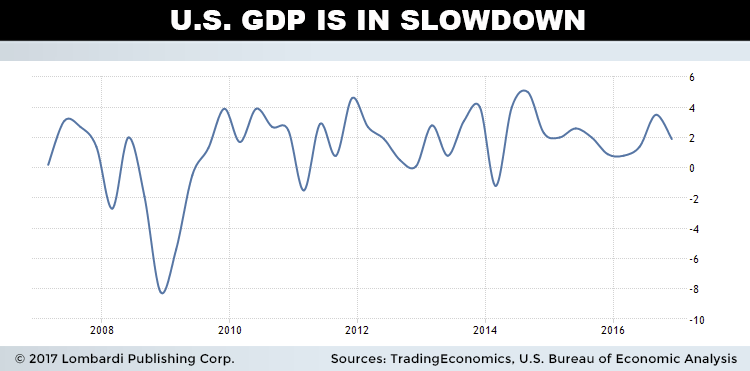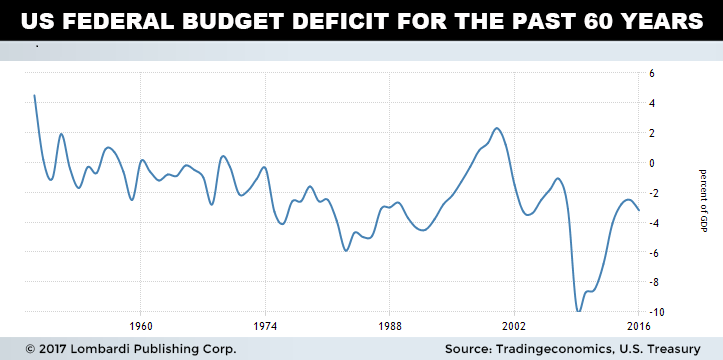Trump Tax Plan Risks Increasing Public Debt, Social Tensions, and U.S. Economic Collapse
The honeymoon between Donald Trump and Wall Street seems to continue. But how long can it last? Wall Street was just shy of its March 21 115-point record after President Trump unveiled his tax plan. But, merely 24 hours later, cooler heads prevailed as analysts realized that U.S. economic collapse has become a serious possibility.
The Trump tax plan is big on tax cuts, but it’s rather short on ideas for how to pay for it. Yes, as Trump boasted, it might be the largest tax cut and the largest tax reform in the country’s history. Yet, it might also be the first salvo of an upcoming economic collapse. This is no exaggeration.
The tax plan has ignored an innocent-looking four-letter word: debt. U.S. public debt could bring down the whole house of cards that is the U.S. economy. The new president would like to imitate—or better yet, beat—President Ronald Reagan. Yes, Trump has no doubt won the “biggest and baddest” tax reform, announcing the biggest tax cut in recent U.S. history.
As to whether it will work, or even pass Congress, that’s another matter altogether.
In the Reagan era, it did not work. At least, it did not work as advertised. There must be a textbook somewhere in every American public library that says lowering taxes is the key to all economic problems. Is there a U.S. economic crisis? Lower taxes; that should do the trick! The best that a major tax cut can produce, however, is that investment and growth resume, but only if everyone agrees to pay the price.
Surging Debt-to-GDP Ratio
That price to be paid is a surging debt-to-GDP ratio and social inequalities increasing. In the 1980s, social inequalities were rising after two of the most “equal” decades in history: the 1960s and 1970s. The wage gap between the highest and lowest earners is a mirage, compared to what it is today. Now, the increasing inequality would come in the wake of an economic recession deeper than the one caused by the Crash of 1929.
President Trump has been busy giving himself high marks for his first 100 days in office. Perhaps, according to the benchmarks he set for himself, he may have earned them. But, as far as the rest of America goes, economic collapse predictions are rising.
The recent statistics suggest that Trump’s four-percent growth U.S. GDP forecast for 2017 needs a downward revision. In fact, the signs point to a potential U.S. economic collapse, possibly even a U.S. economic crisis in 2017.
The U.S. economy grew at its slowest rate in three years in the first quarter of this year. The growth rate was 0.7%; that’s a cold shower on expectations after Trump’s first 100 days in office. Meanwhile, we are told that the U.S. is at near full employment. (Source: “Trump’s 1st economic report card: Slowest growth in 3 years,” CNN, April 28, 2017.)
The full employment must be doing a bad job, since consumer spending—usually a telltale sign of confidence—has dropped. Moreover, one of the most surprising revelations was that military spending has dropped. It has not increased as everyone had expected, given the record high performance of all major defense stocks.
But, if the first quarter of 2017 has fallen below analysts’ expectations, there’s little to hope for the next quarter of the year. The big engine of economic growth was always going to be Trump’s tax cut. In fairness, Trump has unveiled his tax cut, and it’s so deep, it might be described as a tax revolution.
Trump wants to lower the corporate income tax rate from 35% to 15%. That’s a 60% reduction in taxes! Trump’s expectation is that the drastically lower taxes will stimulate strong growth. The idea is that companies will reinvest in their businesses and further reduce the unemployment rate, although that rate is historically low in the U.S. (4.5%).
In addition, Steven Mnuchin, United States Secretary of the Treasury, argues that drastic cuts in the tax rate will not increase the deficit and public debt. He makes this claim, expecting strengthening economic growth and less tax evasion, thus maintaining tax revenue with a much lower rate. That is the “Holy Grail” combination of having a cake and eating it too.
Tax Cuts Won’t Work
There’s no problem eating a cake. But Mnuchin’s logic in the face of what’s happening is better described as eating a cake and not expecting to gain any calories. Trump better have the skills of a wizard, among his talents. Only alchemy could achieve it. But alchemy was less science, and more hocus pocus.
The tax cut would work as intended, if applied. It would be great. But it ignores the proverbial, and rather gigantic, elephant in the room: out-of-control U.S. debt. There’s even proof in the form of the precedent set by President Reagan in the early 1980s. That reform, like Trump’s, comes from the “supply-side economics” handbook.
Reagan’s tax plan did not produce a significant increase in economic growth. Meanwhile, the depleting tax revenue, accompanied by increased public spending, pushed the rise of the government debt from about 30% of GDP to 50% of GDP. Trump is gambling by following the same path.
Yes, there is a minimal chance that, under ideal circumstances, the tax plan might work. The lower tax rate will encourage investment and employment. Thus, even if people are paying less tax, there are more tax entries. The principle was explained by an economist in the 1970s, Arthur Laffer. Like all economists, he explained the problem with a curve: the Laffer curve.
The Laffer curve shows the relationship between tax rates and tax revenue. This allows us to predict whether an increase in the tax rate of an economy would mean an increase or a reduction in tax revenue. The supply-side economics take on the Laffer curve is that, when taxes are low, economic incentives are high, leading to economic growth.
More growth means more employment and more taxpayers. The simplicity of the flat tax, it is reasonable to assume, would also reduce tax evasion. A simple system would make filing taxes easy and painless.
But, what is the ideal tax rate—essentially a flat tax? Calculating this in advance requires an impossible understanding of individual psychologies. Then, there’s the other problem. A flat tax, such that everyone pays the same rate, seems unfair. It forces the poorest to pay as much (in percentage terms) as the richest.
The rich would see a major tax reduction, while the middle and lower classes would barely notice any difference. This will only increase consumption rates at the top, not at the bottom. In effect, Trump’s tax plan would probably result in a shift in wealth from middle- and low-income earners to the wealthiest. This contradicts Trump’s election campaign to raise fortunes of the middle class.
And that’s just the start of the many questions. Indeed, when supply-side economics was applied in the 1980s, the marginal tax rate for the richest was reduced from 70% to 50%. Trump’s tax plan starts from a marginal rate that is already much lower than in the 1980s: about 35%. Yet, Trump still expects the tax cuts to both stimulate a boom in investment (which could happen) and still pay down the rising national debt.
Thus, the direct result is that a tax reduction for the richest and for businesses will not benefit workers. To prevent the national debt from taking off, Trump might have to cut public spending to avoid an excessive increase in U.S. national debt. Cutting public spending would weaken the already rather thrifty (compared to other advanced economies) American welfare system. It would aggravate the lives of the middle and lower classes.
The social effects of such a problem are incalculable. Tensions could erupt beyond current levels, producing challenges to the system not seen since the Boston Tea Party. There is a real possibility that the Trump tax plan could not only trigger an economic crisis, but also spark another U.S. civil war.
For those who would dismiss such drastic scenarios, just think of recent episodes in Baltimore, Ferguson, and Portland. The asymmetric income growth that Trump’s tax plan would establish risks of generating insufficient stimulus for aggregate demand. The latter grows more when lower- and middle-class incomes rise, and less when only the income of the richest grows.
Trump has come up to the White House with a busy schedule, but switching from promise to facts hasn’t proven easy. His economic plan is a high-risk gamble. The payoff might not even be all that great. GDP might grow, but it would do so in a way that benefits a minority. The United States might be heading closer to becoming more like Brazil, and less like Germany.
Tax Plan Would Reduce Federal Revenue
Trump’s tax plan would increase trillion-dollar debt over the next decade, raising interest rates, and slowing down the economy. The markets, so far, have shown unexpected enthusiasm for President Trump’s plans. Indeed, there has been a return of the “irrational exuberance” that former U.S. Federal Reserve Chair Alan Greenspan spoke about in the mid-1990s.
On the flipside, a reduction in the tax rates would significantly increase a company’s earnings per share. This is great for the markets. But there’s a risk that the huge S&P rally of the past few months may have already priced the Trump tax plan advantages into the current valuations. Congress will have to approve Trump’s tax plan and, Republican majority or not, there’s no guarantee it will pass.
The tax plan’s passage remains the great unknown. Republican leaders have made it known that they are substantially in line with the president, but a law formulated in detail could clash with the spectrum of excessive deficits and complex rules. Republicans can vote it in thanks to their majority alone, without the support of Democrats.
But a few Republicans may have some concerns about the national debt. They will push for a dilution of Trump’s proposed tax reform. The markets won’t like anything but a full adoption of the tax cuts.
Meanwhile, the U.S.-North Korea crisis is becoming ever more threatening. A mediation attempt by China’s president Xi Jinping has not worked. Trump says he would do everything to avoid a conflict, but he seems more than willing to opt for a preemptive strike. Thus, apart from the fiscal risks, the markets will have to confront geopolitical uncertainties.
The markets have not yet priced in the uncertainties, because Trump won the White House on a platform of avoiding them.
President Trump spoke about North Korea, suggesting the possibility of a major conflict. The Pentagon has always considered the outbreak of a second Korean war. That’s because, even though the first Korean War included an armistice, signed on July 27, 1953, it did not include a full peace treaty. Trump may pick up where President Dwight D. Eisenhower left off.








